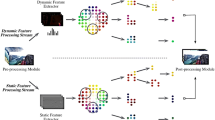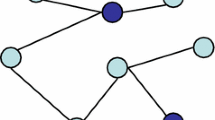Abstract
Both image compression based on color quantization and image segmentation are two typical tasks in the field of image processing. Several techniques based on splitting algorithms or cluster analyses have been proposed in the literature. Self-organizing maps have been also applied to these problems, although with some limitations due to the fixed network architecture and the lack of representation in hierarchical relations among data. In this paper, both problems are addressed using growing hierarchical self-organizing models. An advantage of these models is due to the hierarchical architecture, which is more flexible in the adaptation process to input data, reflecting inherent hierarchical relations among data. Comparative results are provided for image compression and image segmentation. Experimental results show that the proposed approach is promising for image processing, and the powerful of the hierarchical information provided by the proposed model.











Similar content being viewed by others
References
Alahakoon D, Halgamuge S, Srinivasan B (2000) Dynamic self-organizing maps with controlled growth for knowledge discovery. IEEE Trans Neural Netw 11:601–614
Araujo A, Costa D (2009) Local adaptive receptive field self-organizing map for image color segmentation. Image Vis Comput 27(9):1229–1239
Barbalho J, Duarte A, Neto D, Costa J, Netto M (2001) Hierarchical som applied to image compression. In: Anonymous (ed) Proceedings of international joint conference on neural networks, 2001 IJCNN ’01, vol 1, pp 442–447
Beaulieu J, Goldberg M (1989) Hierarchy in picture segmentation: a stepwise optimization approach. IEEE Trans Pattern Anal Mach Intell 11(2):150–163
Bezdek JC (1981) Pattern recognition with fuzzy objective function algoritms. Plenum Press
Bhandarkar S, Koh J, Suk M (1997) Multiscale image segmentation using a hierarchical self-organizing map. Neurocomputing 14(3):241–272
Chang CH, Pengfei X, Xiao R, Srikanthan T (2005) New adaptive color quantization method based on self-organizing maps. IEEE Trans Neural Netw 16(1):237–249
Dittenbach M, Rauber A, Merkl D (2001) Recent advances with the growing hierarchical self-organizing map. In: 3rd workshop on self-organising maps (WSOM), pp 140–145
Dong G, Xie M (2005) Color clustering and learning for image segmentation based on neural networks. IEEE Trans Neural Netw 16(4):925–936
Fan J, Yau D, Elmagarmid A, Aref W (2001) Automatic image segmentation by integrating color-edge extraction and seeded region growing. IEEE Trans Image Process 10(10):1454–1466
Hertz J, Krogh A, Palmer R (1991) Introduction to the theory of neural computation. Addison-Wesley
Kanjanawanishkul K, Uyyanonvara B (2005) Novel fast color reduction algorithm for time-constrained applications. J Vis Commun Image Represent 16(3):311–332
Kassim A, Lee W, Zonoobi D (2009) Hierarchical segmentation-based image coding using hybrid quad-binary trees. IEEE Trans Image Process 18(6):1284–1291
Kohonen T (1982) Self-organized formation of topologically correct feature maps. Bioll Cybern 43(1): 59–69
Lampinen J, Oja E (1992) Clustering properties of hierarchical self-organizing maps. J Math Imaging Vis 2:261
Lhermitte S, Verbesselt J, Jonckheere I, Nackaerts K, Aardt J, Verstraeten W, Coppin P (2008) Hierarchical image segmentation based on similarity of ndvi time series. Remote Sens Environ 112(2): 506–521. Soil Moisture Exp 2004 (SMEX04) Special Issue
Linde Y, Buzo A, Gray R (1980) An algorithm for vector quantizer design. IEEE Trans Commun 28(1): 84–95
Lopez-Rubio E, Luque-Baena RM, Domínguez E (2011) Foreground detection in video sequences with probabilistic self-organizing maps. Int J Neural Syst 21(3):225–246
Luque RM, Domínguez E, Palomo EJ, Muñoz J (2008) A neural network approach for video object segmentation in traffic surveillance. In: Springer (ed) Lecture Notes in Computer Science, vol 5112, pp 151–158
Maddalena L, Petrosino A (2008) A self-organizing approach to background subtraction for visual surveillance applications. IEEE Trans Image Process 17(7):1168–1177
Ohkura K, Nishizawa H, Obi T, Hasegawa A, Yamaguchi M, Ohyama N (2000) Unsupervised image segmentation using hierarchical clustering. Optical Review
Palomo EJ, Domínguez E, Luque RM, Muñoz J (2009) Image hierarchical segmentation based on a ghsom. In: Leung C, Lee M, Chan J (eds) Neural information processing, Lecture Notes in Computer Science, vol 5863. Springer, Berlin, pp 743–750
Palomo EJ, Domínguez E, Luque RM, Muñoz J (2011) Lossy image compression using a ghsom. In: Proceedings of the 11th international conference on artificial neural networks conference on advances in computational intelligence—volume Part II, IWANN’11, pp 1–8 Springer-Verlag, Berlin, Heidelberg
Pan Y, Birdwell J, Djouadi S (2009) Preferential image segmentation using trees of shapes. IEEE Trans Image Process 18(4):854–866
Rauber A, Merkl D, Dittenbach M (2002) The growing hierarchical self-organizing map: Exploratory analysis of high-dimensional data. IEEE Trans Neural Netw 13(6):1331–1341
Sharon E, Galun M, Sharon D, Basri R, Brandt A (2006) Hierarchy and adaptivity in segmenting visual scenes. Nature. doi:10.1038/nature04977
Wei Y, Fritts J, Sun F (2002) A hierarchical image segmentation algorithm. In: IEEE International Conference on Multimedia and Expo, vol 2, pp 221–224
Xiaojun D, Bui T (2006) A new hierarchical image segmentation method. In: 18th international conference on pattern recognition, pp 108–112
Zhouyu F, Robles-Kelly A (2008) A fast hierarchical approach to image segmentation. In: 19th international conference on pattern recognition, pp 1–4
Acknowledgments
This work is partially supported by the Ministry of Economy and Competitiveness of Spain under grant TIN2011-24141, project name Detection of anomalous activities in video sequences by self-organizing neural systems, and the Autonomous Government of Andalusia (Spain) under project P12-TIC-6213, project name Development of Self-Organizing Neural Networks for Information Technologies.
Author information
Authors and Affiliations
Corresponding author
Rights and permissions
About this article
Cite this article
Palomo, E.J., Domínguez, E., Luque-Baena, R.M. et al. Image Compression and Video Segmentation Using Hierarchical Self-Organization. Neural Process Lett 37, 69–87 (2013). https://doi.org/10.1007/s11063-012-9266-5
Published:
Issue Date:
DOI: https://doi.org/10.1007/s11063-012-9266-5




